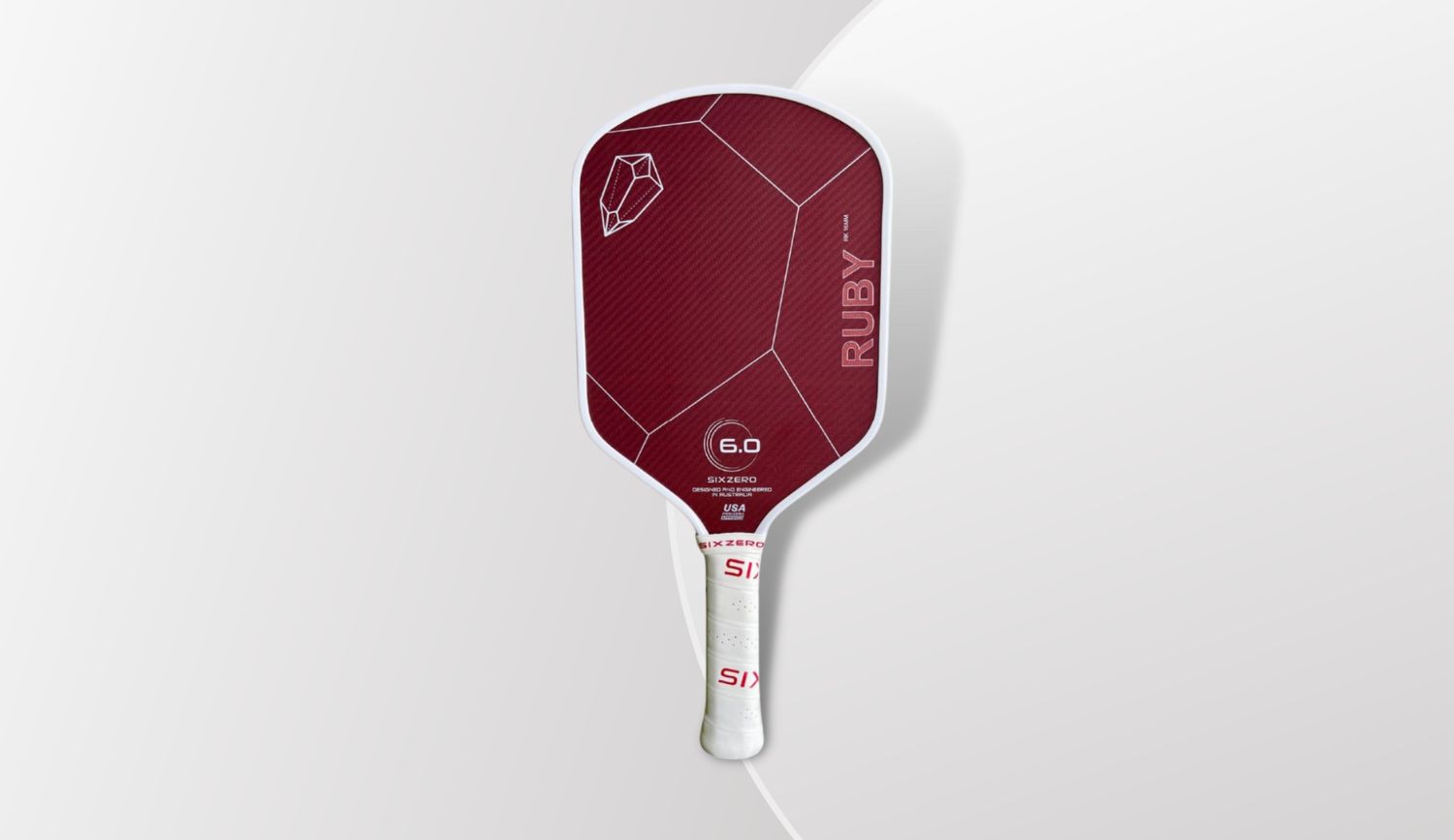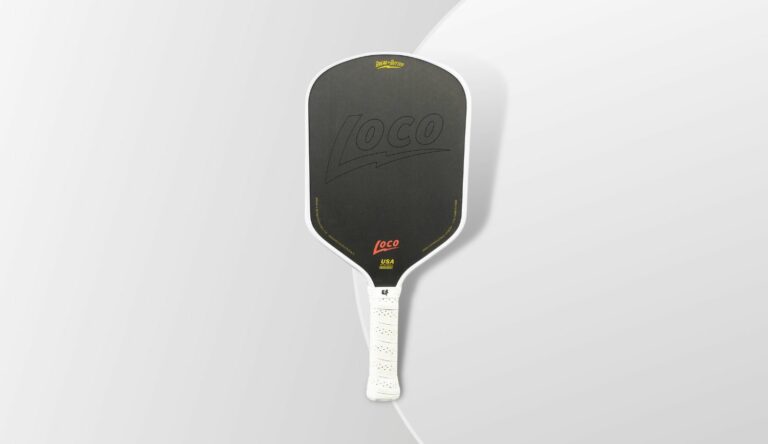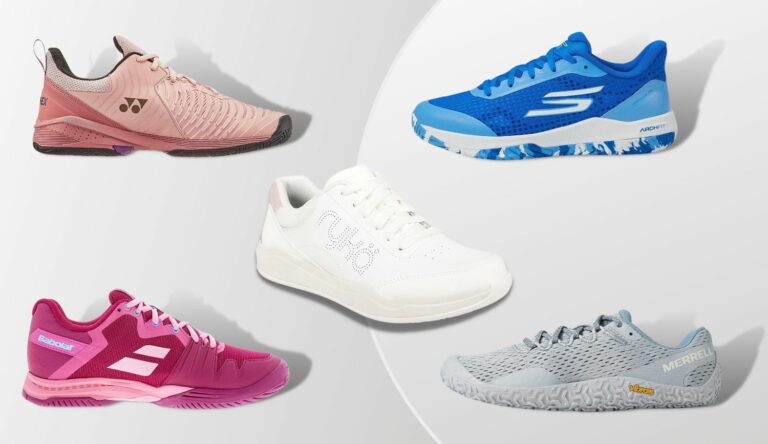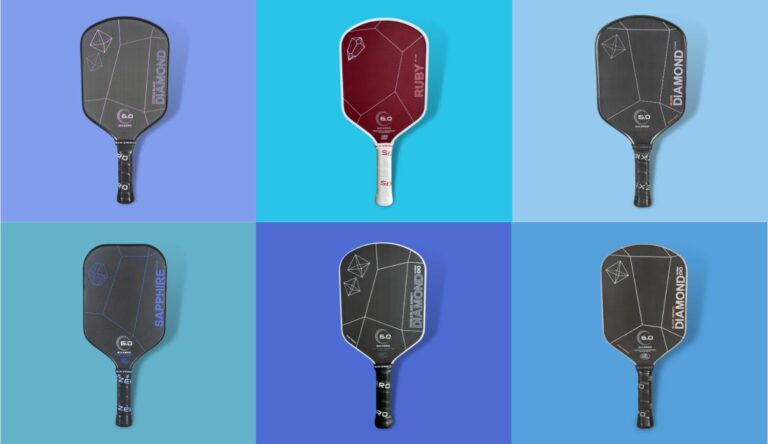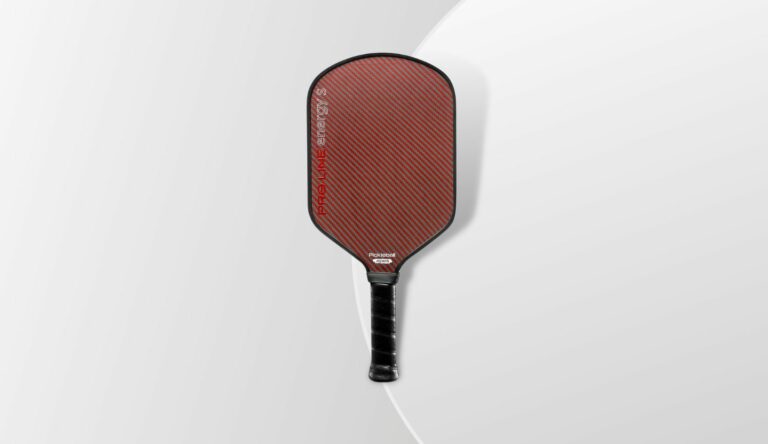I’ve been rigorously play-testing Six Zero’s paddles since the brand’s release last year. While the Double Black Diamond has been their most revelatory paddle, the new Ruby stands out in a big way and has been the most fun to play with.
I’m thrilled to provide you with a detailed review of the Ruby’s performance and capabilities in this article. I cover the Ruby’s new Kevlar material and how it handles performance factors like power, spin, control, pop, and more. I’ll also compare it with other popular Six Zero paddles to highlight similarities and differences you need to know about.
By the end, you’ll have all the info required to determine if the Ruby is a worthwhile paddle for you to pick up in your quest to take your game to the next level. I also recommend checking out my Complete Six Zero Paddles Buyer’s Guide.
Contents
Six Zero Ruby Technical Specifications
- Price:
$199($180 with Discount Code DASHPB) - Shape: Hybrid (between elongated and square)
- Core: Narrow-cell Honeycomb Polypropylene
- Core thickness: 16mm
- Face: 100% Dupont Kevlar
- Handle length: 5.5″
- Grip circumference: 4.25″
- Average weight: 8.2 oz +/- .02oz
- Swingweight: 118
- Twist Weight: 6.79
- Thermoformed: Yes
- Total length: 16.3″
- Width: 7.6″
- Warranty: 12 months for defects, 6 months for core material
Link Applies Discount Code DASHPB at Checkout
Quick Summary
The Ruby is a well-rounded paddle that features new tech and is a slightly better performer in key areas over the ever-popular Double Black Diamond. The Ruby has the same shape and overall dimensions (minus some handle size variations) as the original Double Black Diamond.
The Ruby’s main differentiator in Six Zero’s paddle line is its Dupont-sourced Kevlar face compared to the raw carbon fiber face of other Six Zero paddles. The result is that the Ruby provides slightly more power, touch, stability, and spin over the Double Black Diamond and Double Black Diamond Infinity. The Ruby does have less pop output than the DBD and BD, which could be seen as either positive or negative, depending on the player.
Like other Six Zero paddle offerings, I was instantly impressed when I first hit the courts with the Ruby. Its first-to-market fully Kevlar face has a great blend of control, spin, power, pop, and feel/touch. The responsiveness of the Kevlar face may take a moment for some players to adjust to, but I’ve felt comfortable with it right from the start.
The Ruby is lively enough at the kitchen to counter and speed up your volleys with authority while being muted enough to shape shots with finesse and great touch. Mishits don’t feel too harsh with the Ruby thanks to its large and forgiving sweet spot. It’s plenty stable to block and counter tough shots with since it comes in on the heavier side for a hybrid-shaped paddle.
Feel
Handle
The Ruby handle features the same ergonomic design seen across Six Zero’s premium paddle line. Its contoured shape is a good match for players of various hand sizes. At 5.5 inches, the handle length lands in a nice range for easily accessible two-handed shots. I have zero complaints about the handle.
Weight and Balance
The Ruby has an average weight of 8.2 ounces, which is slightly heavier than the DBD and BD, though still light enough to provide a balanced and maneuverable feel for most players.
Some players will not enjoy the Ruby’s weight and want something a bit lighter, especially if their Ruby comes in at 8.4 oz or higher, as I’ve heard some players complain about. Mine personally came in at 8.25 oz, which is an ideal base weight for me. I’ve also heard of people getting 7.9 oz Ruby’s, though. So there is a big variance.
The paddle is mostly balanced, maybe with a slight head heaviness. It feels plenty quick with a swing weight of 117. It’s not the quickest, but is definitely in the optimal range for a hybrid paddle.
How the Ruby feels hitting the Ball
The Ruby’s Kevlar face gives it the most muted feel of the Six Zero paddle lineup. It’s definitely plush, but it’s still a thermformed paddle. If you haven’t played with a thermo yet, don’t expect all this plush talk to give you the sense that the Ruby feels like a Joola Hyperion. It’s not that soft. Also note that it takes a 5+ hours of play to really break in. It’ll feel quite stiff at first, like other Six Zero paddles.
Power
Six Zero paddles are thermoformed, so even their control-focused offerings, like the Ruby, will give your game plenty of power.
In my testing, I’ve found that the Ruby has slightly more power than the Double Black Diamond and DBD Infinity while being slightly less powerful than the Black Diamond Power paddle.
It’s a bit less poppy than those paddles, so the Ruby’s power really shows up on big, full drives where the increased dwell time can really grip and rip through the ball.
I’ve also found that the Ruby’s power really shines when you add spin to the mix. The Ruby has insane spin output (more on that later). And when you combine its potent spin with power shots, such as top-spin serves and drives, the Ruby absolutely crushes.
Pop
Pop is measured by how potent the the ball rebounds off on quick shots like counters, blocks, flicks, etc. The Ruby has less pop than most of the thermoformed paddles that I’ve played with, and is notably less poppy than the DBD and BD. The Ruby’s pop output is similar to the R1 Pulsar and Pickleball Apes Pro Line Energy S.
This diminished pop is mainly attributed to the Ruby’s 100% Kevlar surface. Kevlar is less stiff and more impact-absorbing than carbon fiber, resulting in a more plush and less poppy result on contact. As a result, I’d say that its pop is closer to a non-thermoformed paddle, though not as close as fellow the Kevlar-faced thermoformed Pro Line Energy.
If you love the pop that you get from other thermoforms, then you might be disappointed by the Ruby’s pop output. But, if you prefer the power of a thermoformed paddle that sacrifices some pop for great touch to help with resets and drops, then the Ruby might be right up your alley.
Control
In my experience, the Ruby is Six Zero’s most controllable paddle to date. The Ruby retains impressive touch and feel despite its high power output, which you don’t always see with thermoforms. Compared to the DBD, the Ruby also has a bigger sweet spot, more spin, and a higher twist weight (resulting in more stability and less vibration). The Ruby performs the best out of all Six Zero paddles in these areas, directly improving the Ruby’s controllability.
The muted, plush feel of the Ruby’s kevlar surface provides extra dwell time and improve its feel, touch, and spin performance. The ball sinks into the Ruby’s paddle face. It really grabs the ball and enables you to shape your shots.
The high spin output of the Ruby really helps improve the controllability of the paddle. It enables you to hit extra hard topspin drives and speedups that drop fast and easily stay in bounds. If you know how to use spin on your dinks, you can be very aggressive when dinking.
I like the Ruby’s feel and controllability the most out of any Six Zero paddle, but you do have to break it in a bit to get full access to its excellent touch potential. It took me a few hours of play to really break it in. The extra large sweet spot is confidence-building because you don’t have to worry so much about mishits when hitting the ball off center.
Spin
The Ruby shines with top-tier spin. The paddle face was the grittiest I’ve played with yet from Six Zero. I’m able to hit RPMs well north of 2,000 with the Ruby, as high as 2,250. This is the most spin output from any Six Zero paddle I’ve used to date.
You can shape shots in a huge way with the Ruby. I actually had to adjust my top-spin serves/drives and slice returns to accommodate the extra spin I got with the Ruby. This was surprising, as I typically use very high-spin paddles. Initially, my top-spin shots kept landing more shallowly than I expected, and my slice returns floated too far. This is a key indicator that the spin output of the Ruby was higher than that of other paddles I’ve used.
Once dialed in, I could hit top-spin serves and slice returns deep with consistency, creating a massive challenge for my opponents. My spin dinks came easier and enabled my dinking game at the net to be much more aggressive. Ultimately, palyers who utilize spin will benefit hugely from the Ruby’s capabilities.
Maneuverability/Hand Speed
The Ruby is fast in hand. It’s not the lightest or quickest paddle, but its 117 swing weight is on par for hybrid-shaped paddles (the Double Black Diamond has a 116 swing weight). The Ruby is an easy paddle to get back in place after hitting a speedup or counter and won’t feel tiring to play long sessions with. If you’ve played with the DBD already, it’ll feel just about the same.
Durability
The Ruby is made with thermoformed production methods, so it features a very stable unibody construction that holds up and won’t easily break. There’s been issues with delamination, disbonding, and core-crushing with thermoformed paddles in the past, but Six Zero has addressed these issues effectively, so you don’t see delamination with their newer paddles much at all anymore.
In terms of surface durability, there’s a lot of hype about the Ruby’s Kevlar face having a uniquely long-lasting surface grit, but the verdict is still out on the Ruby’s kevlar face durability. A a newer material to pickleball paddles, the longevity of Kevlar faces remains unquantified over the long term compared to carbon fiber. But Kevlar itself boasts exceptional durability properties – five times stronger than steel on an equal weight basis. Translated into a paddle, this suggests improved impact resistance and protection against premature damage, nicks or wear.
My Ruby’s Kevlar surface has held up well so far, but I’ve heard that some people have lost some grit at a pretty quick rate. Time will tell on this front.
Value
The Ruby retails at $199 or $180 when discounted with code DASHPB. As far as premium paddles go, this is a great price for what you’re getting. Six Zero’s paddles are high-quality, high performers that have proven to be well worth the investment.
With the Ruby providing a first-to-market full Kevlar face and featuring improved performance over the ever-popular Double Black Diamond in numerous areas, the $180 price is absolutely worthwhile. If the Ruby were to be released by one of the bigger companies like Joola or Selkirk, you could bet that it’d be $220+.
Link Applies Discount Code DASHPB at Checkout
Who Should Buy the Six Zero Ruby Paddle?
You should pick up a Ruby if you want an all-court thermoformed power that excels at power, control, and spin. The Ruby is my top recommended thermoformed paddle right now because of its high-performance marks, easily topping the Double Black Diamond as my previous top recommendation for thermoformed-leaning players.
The Ruby is such a stud of a paddle because you get this amazing blend of power and control plus absolutely top-tier spin. The touch, especially with dinking and on the soft game, is unique and highly appealing.
As such, it’s pretty easy for me to recommend the Ruby to the thermoformed curious and thermoformed aficionados. That said, if you already have a great thermoformed paddle like the Double Black Diamond, then you don’t need to feel FOMO and invest in the Ruby compulsively. Pick a Ruby up if you want, but your DBD is still solid, even if slightly less of a performer than the Ruby.
The one group that I wouldn’t suggest the Ruby to as my #1 recommendation would be those who crave the highest level of pop. The Ruby simply lacks pop compared to raw carbon fiber-faced thermoformed paddles. So if pop is what you’re after, I’d recommend the Black Diamond above all other Six Zero paddles. Otherwise, I’d go with the Ruby all the way.
Link Applies Discount Code DASHPB at Checkout

Stay in the loop
Get pickleball news, educational guides, and gear advice sent to your email in a once a week round-up post.
